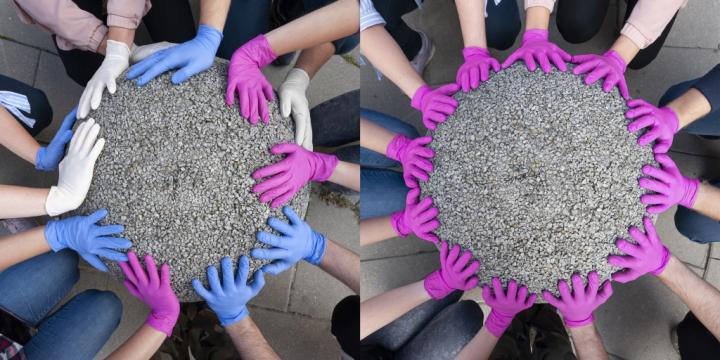
Credit: IPC PAS, G.Krzyzewski
Nanocrystalline zinc oxide (ZnO) is currently one of the most commonly used semiconductor metal oxide nanomaterials due to its unique catalytic and electro-optical characteristics. The inherent and distinctive physicochemical properties of ZnO nanostructures are dependent on a variety of factors that are determined by the applied synthetic procedure and the character of the resulting nanocrystal-ligand interface. Thus, the preparation of stable ZnO nanostructures, especially nanoparticles with sizes below 10 nm, i.e. quantum dots (QDs), with desired physicochemical properties still remains a huge challenge for chemists. Recently, scientists from the Institute of Physical Chemistry of the Polish Academy of Sciences (IPC PAS) and Warsaw University of Technology (WUT) in cooperation with the Interdisciplinary Research Institute of Grenoble (IRIG) used dynamic nuclear polarization (DNP)-enhanced solid state nuclear magnetic resonance (NMR) spectroscopy for detailed characterization of the organic-inorganic interfaces of ZnO QDs prepared by the traditional sol-gel process and the recently developed one-pot self-supporting organometallic (OSSOM) procedure. In parallel, investigations were carried out on the design and preparation of bio-stable ZnO QDs along with the determination of their structure-biological activity relationship. These studies were published in the high-impact journals “Angewandte Chemie” and “Scientific Reports“.
“We wanted to unambiguously confirm that ZnO QDs prepared in our laboratory using the OSSOM approach are of unprecedentedly high quality,” recounts co-author of both papers, Dr. Ma?gorzata Wolska-Pietkiewicz. “Up to now, ZnO QDs have been commonly produced by a sol-gel process. However, the main disadvantage of this traditional method is the low reproducibility, which likely inhibits both the uniformity of particle morphology and organic ligand shell composition. Consequently, the resulting nanostructures are essentially unstable and tend to aggregate. In my opinion, this has significantly limited potential applications of nanocrystalline ZnO in various technologies,” adds Dr. Wolska-Pietkiewicz.
“An alternative to the omnipresent sol-gel method are highly promising wet-organometallic approaches. Recently developed in our laboratory, the OSSOM procedure is based on the controlled exposition of a well-defined organozinc precursor to air. The OSSOM process is thermodynamically controlled and occurs at room temperature,” says Professor Janusz Lewi?ski. To highlight the superiority of the organometallic approach for the preparation of ZnO QDs, both the procedure-driven properties as well as the structures of the organic ligand shells of QDs prepared by both the OSSOM approach and the sol-gel procedure were compared. For this purpose scientists applied the DNP-NMR method that is being developed in the group of Dr Gaël De Paëpe (IRIG). “This NMR technique allows us to study nanomaterials’ interfaces with atomic precision and thus to demonstrate the difference between tested materials,” continues Dr. Daniel Lee and adds that the ability to determine the exact nature and structure of the interface gives a valuable insight into future designs for new and fully stable functional nanomaterials. In addition, DNP-NMR measurements are relatively fast and take only a few hours. This really isn’t much, especially compared to conventional NMR spectroscopy, which (in the case of measurements with comparable resolution) would require … about a year.
“The OSSOM method leads to the formation of ZnO QDs coated with strongly anchored and highly-ordered organic coatings. Contrastingly, on the surface of sol-gel derived ZnO nanostructures, coating ligand molecules are randomly distributed,” Dr. Wolska-Pietkiewicz points out. What is more, ligands could be easily removed from the surface of QDs derived from sol-gel process, changing the properties of the resulting nanomaterial. “In our method, the surface is super-protected, and QDs are stable. As a result, the OSSOM approach affords high-quality ZnO QDs with unique physicochemical properties, which are prospective for biological applications,” adds Dr. Wolska-Pietkiewicz.
Why it is so important?
“This preliminary study has only just scratched the surface (pun intended) of what can be achieved.” – says Dr. Lee. “We have shown that being able to study nanomaterials’ surface stability at an atomic scale enables the understanding of how to provide their stability, which is extremely important from the point of view of subsequent applications: from sensors and optical devices to targeted drug delivery and nanomedicines.”
“In the near future, we could design, for example, safe and effective drug nanocarriers for cancer therapies, in which we would be able to deposit appropriately selected, active molecules within our ordered organic layer. Positioning is important especially for targeted therapies, e.g. photodynamic therapy, because it allows the drug to be released evenly in a particular environment and at the right speed. In addition, owing to the achieved ligands ordering, we are able to pack a lot of active drug particles on a small carrier” adds Professor Lewinski.
###
Media Contact
Janusz Lewinski
[email protected]
48-223-432-076
Related Journal Article
http://dx.




